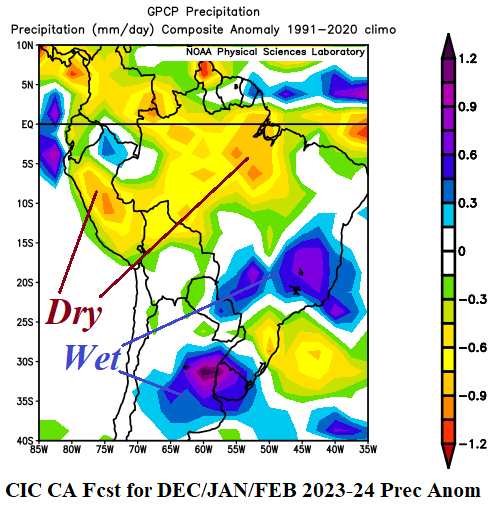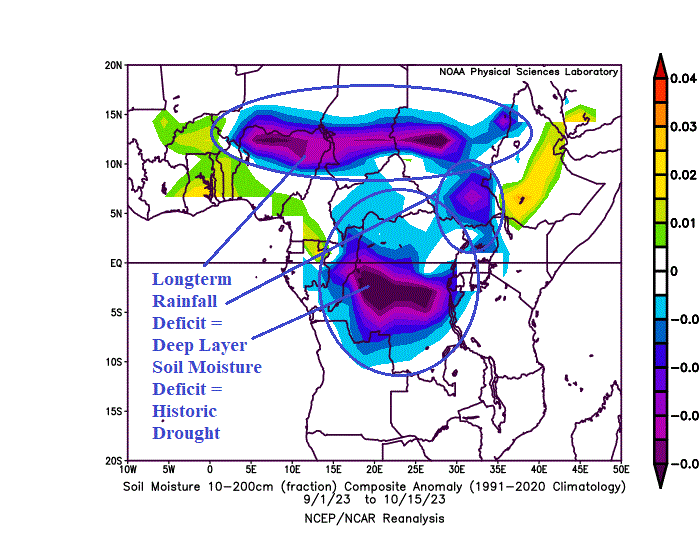
Where Is The Worst Drought/Drought Potential Areas?
10/18/2023, 8:27 am EDT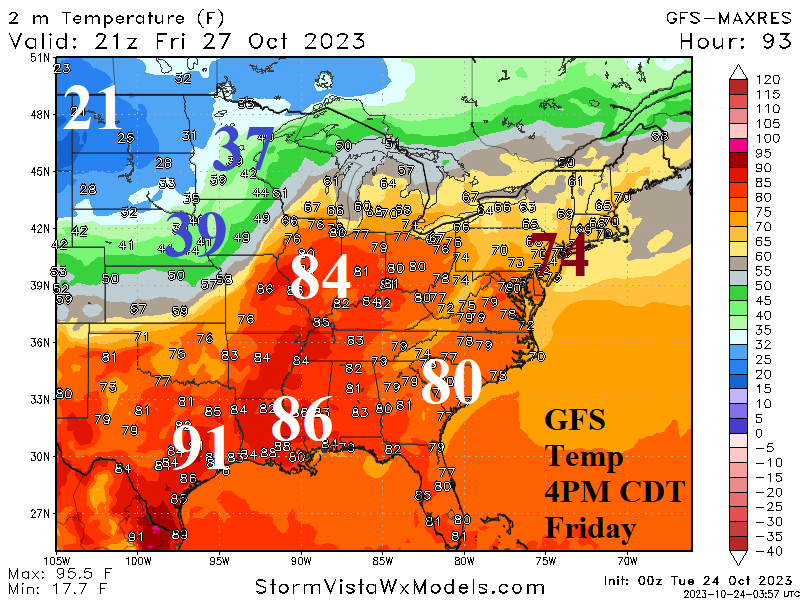
U.S. Weather Pattern Heading Toward Extremes
10/24/2023, 8:39 am EDTExecutive Summary: The Climate Impact Company season 1-3 ahead climate forecast for South America is updated. The forecast is based on a constructed analog rooted in regional SSTA regimes and their historical upper air patterns. Highlights include the likely evolution of Central Brazil drought during summer 2023-24 possibly expanding eastward during early autumn. Wet climate shifts into Northeast Argentina easing long-term drought in that region. Next winter brings a cooler than normal regime to Argentina with above normal risk of important chill reaching Southern Brazil.
Methodology: The Climate Impact Company (CIC) season 1-3 ahead climate forecast is valid for DEC/JAN/FEB 2023-24 through JUN/JUL/AUG 2024. The forecast is based on a constructed analog (CA). The constructed analog is based on prevailing upper air patterns associated with El Nino, El Nino and positive phase Indian ocean dipole (+IOD), Amundsen Sea low pressure, and high pressure associated with a marine heat wave east of Argentina.
Climate discussion: Much of South America is in midst of a long-term drought pattern inspired by the 2020-23 La Nina climate. In addition to below normal rainfall, the climate pattern was record warm through the last 12 months including the warmest September on record. The consistently warmer/hotter than normal climate increases evaporation of soil moisture. The long-term drought causes many emergencies lead by low ground water for much of Brazil and Argentina, historic low river levels delaying or preventing travel, and general lowered access to water with Amazonia and Bolivia hardest hit.
Soil moisture conditions across the soybean, wheat, and corn growing regions of Brazil/Argentina vary. Hardest hit by drought is across Argentina. In Brazil, the wheat growing areas are generally wet while a northward trend finds drought in the second corn crop and northern soybean region (Fig. 1). The long-term dryness has limited the beneficial influence of wetter than normal climate across much of the eastern half of Brazil during the past 90 days with exception of far Southeast Brazil (Fig. 2).


Fig. 1-2: The daily soil moisture anomalies across South America and past 90 days percent of normal rainfall.
Oceanic El Nino formed last June and has intensified while atmospheric El Nino has recently developed. The latest Climate Impact Company constructed analog ENSO phase forecast finds the unusual combination of a buoyant oceanic El Nino peaking during summertime and steadily weakening next year (Fig. 3). Multivariate ENSO index (MEI) which measures the strength of warm El Nino waters of the eastern equatorial Pacific on the global climate pattern indicates a considerably weaker El Nino climate. The leading catalyst to the season 1-3 ahead climate forecast for South America is El Nino peak during upcoming summer, decelerating El Nino next spring, and neutral ENSO shifting toward La Nina next winter.
Additional climate impacts on South America during recent years are caused by the upper air patterns associated with a semi-persistent cool pool of ocean water southwest of South America to the north of the Amundsen Sea on the north coast of Antarctica and an equally persistent marine heat wave east of Argentina. During the past 3 years each of these features has appeared and created hot and dry enhancement across Northern Argentina and Central Brazil (Fig. 4).
The Amundsen Sea trough associated with cooler SSTA southwest of South America and upper ridge associated with the Argentina MHW are forecast to regenerate during summer 2023-24 although not quite as intense as the past 3 seasons according to the global SSTA forecast valid for January (Fig. 5). Note the core of the anomalous warmth in the El Nino zone of the eastern equatorial Pacific Ocean is expanding westward. Additionally, a strong positive phase Indian Ocean dipole is present. During summer seasons when +IOD and El Nino are present, the South America climate has a tendency for very wet conditions in Northeast Argentina while central and northern Brazil are very dry (Fig. 6).
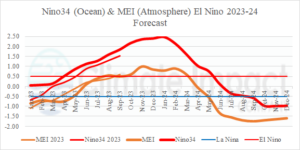
Fig. 3: The Climate Impact Company oceanic and atmospheric ENSO outlook.
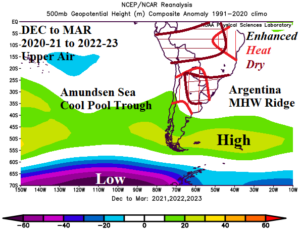
Fig. 4: Prevailing upper air pattern during DEC-MAR the past 3 years due to the Amundsen Sea trough and east of Argentina ridge.
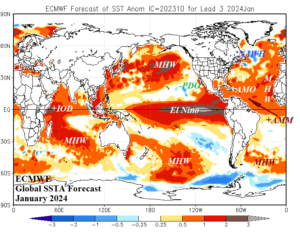
Fig. 5: The ECMWF global SSTA forecast for January 2024 and areas of influence on climate forecasts.

Fig. 6: Based on the last 3 analogs, the prevailing rainfall pattern across South America during DEC to MAR when El Nino is accompanied by +IOD.
Please see the South America month 1-4 outlook for each monthly forecast.
DEC/JAN/FEB 2023-24: The summer 2023-24 outlook is hotter than normal across Brazil into Northeast Argentina and cooler than normal Central Argentina and southward. The northwest continent is also hotter than normal. A dry climate is forecast across northwest continent and the northern/western portion of Brazil. A wetter than normal summer climate is expected across Northeast Argentina to Southeast Brazil and Interior Southeast Brazil. The forecast is consistent with the previous outlook except slightly wetter Interior Southeast Brazil. In this scenario, Central Brazil shifts into drought.


Fig. 7-8: The Climate Impact Company constructed analog forecast of temperature and precipitation anomalies valid for DEC/JAN/FEB 2023-24.
MAR/APR/MAY 2024: Mature El Nino and an ending of the +IOD pattern spawns a dry and warmer than normal climate across Brazil. The Central Brazil summertime drought may expand eastward. Southeast Brazil remains wetter than normal. Wet climate also extends to Northeast Argentina where long-term drought eases. Argentina is forecast cooler than normal for the autumn season. The forecast is consistent with the previous outlook.
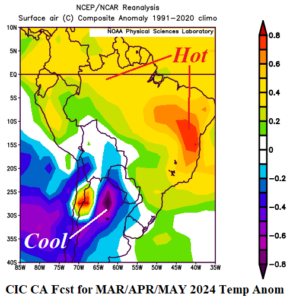
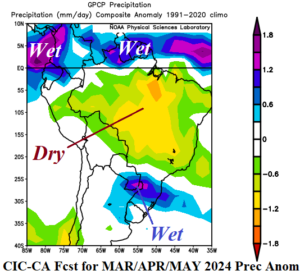
Fig. 9-10: The Climate Impact Company constructed analog forecast of temperature and precipitation anomalies valid for MAR/APR/MAY 2024.
JUN/JUL/AUG 2024: Next winter is warmer than normal across most of Brazil while cooler conditions are projected in Argentina. There is above normal risk of important chill reaching Southern Brazil. The climate pattern is seasonably dry in most areas.
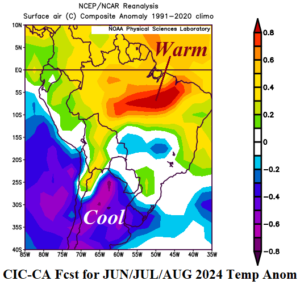
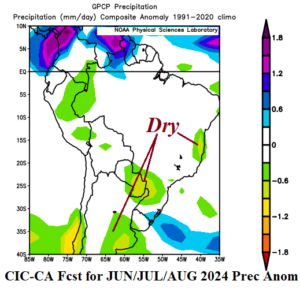
Fig. 11-12: The Climate Impact Company constructed analog forecast of temperature and precipitation anomalies valid for JUN/JUL/AUG 2024.
![Climate-Impact-Company-logo-sm[1]](https://climateimpactcompany.com/wp-content/uploads/2023/08/Climate-Impact-Company-logo-sm1.png)
